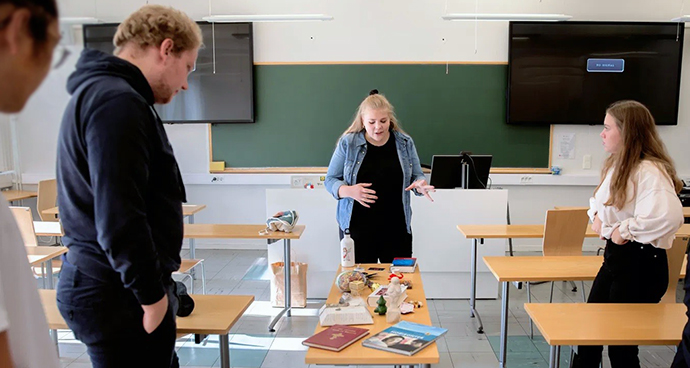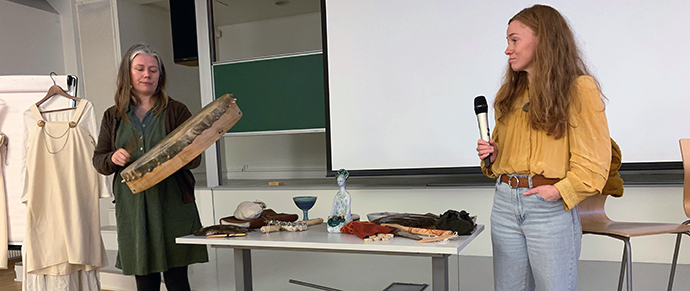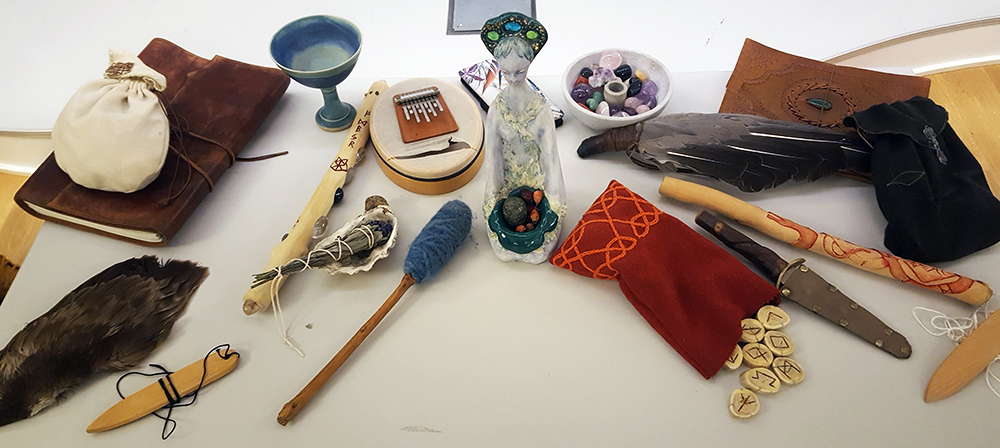A first year course in lived religion
A key argument within lived religion research is that it is not enough to read authorized texts, measure attendance at services and events or study history of religion. In addition, one also needs to examine how religion actually is lived. As one of the pioneers of lived religion, Meredith McGuire, put it: to study lived religion requires attuning oneself to the spiritual meanings and religious experiences people encounter (McGuire, 2016). Within lived religion, direct exposure to places and people enacting religion is a prerequisite. Thus, sensing religion is an important part of how religion make sense.
I have, in cooperation with colleagues and seminar teachers at The Faculty of Theology, developed a first- year course addressing lived religion in Norway. The course is mandatory for all students at the theology program and for the BA Religion and society. It is also part of the teacher-training program (Lektorprogrammet) at UiO. Students from BA programs at the Faculty of Humanities and the Faculty of Social Sciences can also chose the class as one of their elective courses. About 60-70 students enrolled in 2020, and a similar number has completed the course in 2021. The overall aim is to give undergraduate students a nuanced understanding of how and why different kinds of spirituality are part of the everyday life of individuals and institutions in a late modern society. In order to realize this aim, we had to find ways in which students could get first person experiences of religion as lived, embodied practices and rituals.
Students as a lived religion resource
Students themselves are one of the most appropriate resources for exploring lived religion. Everyone has some kind of experience with religions and worldviews. Consequently, the first mandatory course task concerns positionality. Anchored in theoretical debates about researcher positionality and reflexivity, every student is invited to reflect upon their own experiences in small seminar groups. Students then write an essay about how previous experiences with religion – broadly understood – frames their initial understanding of religious practices and people. The argument is that in order to understand the lived religion of others, one has to be knowledgeable about oneself first. To reflect about oneself, as part of a university course, has been unexpected and unfamiliar for most students, and particularly to more experienced students. Some have reported uneasiness when talking about themselves, but the majority understands why it is important to do so. Overall, by the end of the term students frequently mention new insights about themselves and report having learned a lot by listening to the other students.

Experiences from religious education
Their second mandatory task in our course involves gathering some empirical lived religion material. To make this task manageable and ethically responsible, we have restricted their options. Almost every student living in Norway has experienced religious education as part of his or her schooling. This makes fellow students highly relevant in a lived religion perspective. Students can, for example, chose to conduct small interviews with fellow students about religion in school. Thus, some have explored how students have experienced teaching about their own religious tradition or traditions. Others have studied how students identifying as nonreligious reflect about school visits to local congregations. Importantly, the students only take notes. We do not allow any recorded material or gathering of personal data or person-identifiable information.
Field visits to churches and mosques
 The second possibility we provide is a field-visit to a publicly announced religious activity in a mosque or in a church. The students choose amongst Christian and Muslim congregations and organizations with whom we have established a cooperation. Contact persons in each congregation or organization know when the students are coming, and the students know that they are present as observing guests, participating if it is appropriate. Discreet note writing is sometimes possible, but recording and person-identifiable data collection are not allowed. Many students experience that the lived religion approach become much more understandable after such a visit. Theorizations about rituals as an expressive activity, embedded and accomplished in a through the body (McGuire, 2016), are coming more alive when are part of a Friday prayer or a Sunday or weekday worship service. Actually being there gives them a sense of what it means for those attending, and sometimes it adjusts prejudices about religious practices and people. Still, arranging for students in their first year to visit actual religious activities contains risk. To reduce the risk, every student is obliged to have an individual plan describing how he or she will conduct his or her visit. Nobody can visit before his or her seminar teacher has approved his or her observation guide. Happily, we have not had any reports back about inappropriate behavior. We are thankful for the way Christian and Muslim congregations and organizations welcome our students. Thus, this educational innovation depends on long-term relationships between religious leaders in Christian and Muslim congregations and organizations and The Faculty of Theology.
The second possibility we provide is a field-visit to a publicly announced religious activity in a mosque or in a church. The students choose amongst Christian and Muslim congregations and organizations with whom we have established a cooperation. Contact persons in each congregation or organization know when the students are coming, and the students know that they are present as observing guests, participating if it is appropriate. Discreet note writing is sometimes possible, but recording and person-identifiable data collection are not allowed. Many students experience that the lived religion approach become much more understandable after such a visit. Theorizations about rituals as an expressive activity, embedded and accomplished in a through the body (McGuire, 2016), are coming more alive when are part of a Friday prayer or a Sunday or weekday worship service. Actually being there gives them a sense of what it means for those attending, and sometimes it adjusts prejudices about religious practices and people. Still, arranging for students in their first year to visit actual religious activities contains risk. To reduce the risk, every student is obliged to have an individual plan describing how he or she will conduct his or her visit. Nobody can visit before his or her seminar teacher has approved his or her observation guide. Happily, we have not had any reports back about inappropriate behavior. We are thankful for the way Christian and Muslim congregations and organizations welcome our students. Thus, this educational innovation depends on long-term relationships between religious leaders in Christian and Muslim congregations and organizations and The Faculty of Theology.
Lived religion in a public hospital

Still, other fields within lived religion are less empirically accessible than churches and mosques. In order to make lived religion in hospitals come alive as concrete experiences, we have invited guest lecturers who work at hospitals. In 2020 Naveed Baig, hospital imam at Copenhagen University hospital, told about the kinds of existential and religious care Muslim patients request. This autumn we invited Nina Zimmer from Oslo University hospital. She explained how the hospital facilitates different kinds of rituals for foetus and stillborn babies. Her professional responsibilities include taking care of and cleaning foetus and stillborn babies, and guiding and supporting parents in the farewell they chose. The guest lecturer visits enabled conversations about how public institutions are in processes of transformation, and how new practices are invented when the society become more religiously diverse. However, to see a tiny coffin in a lecture hall is not an everyday experience. To manage the emotional intensity, we did as we do in every lecture and considered the dimensions of lived religion that guide the course more generally: embodiment, materiality, discourse, emotion, aesthetics, morality and spirituality (Ammerman, 2020). These theoretical concepts made it possible to talk about a very sensitive theme in a language the students recognized. Several students expressed gratitude afterwards. We are grateful for the way our visitors shared their experiences with our students.
Sensing shamanistic rituals

Lived religion emerged in the late 1990s as an interest in how people construct their religious worlds outside established religious communities (McGuire, 2008). Later, lived religion has developed to how mainline congregations, and beyond, enact religious worlds by their doings and sayings (Ammerman, 2016, Ammerman, 2013). Examining religious experiences outside formalized religious communities is still important. However, empirical access to less formalized kinds of lived religion is often a challenge. People involved in holistic or alternative spiritualties often come together in loosely organized network and small groups (Gilhus et al., 2017). Arranging field visits to these kinds of groups was not a feasible option. Instead, we invited two guests. In 2021, Ylva Linnestad and Renate Elida Haug, who have their own shamanistic practice and arrange open shamanistic rituals regularly, came to visit us. As in every other lecture, we combined analytical lived religion concepts with their empirical narratives and illustrations. Without participatory involvement of the students, Linnestad and Haug showed how they use different material objects like feathers, incense and runes in their rituals. Overall, the visit made lived religion arguments about the need to experience religion in order to understand how it makes sense more apprehensible for the students.
Recommending the course to other students
This review shows that it is possible to find ways to give first-year students concrete experiences of lived religion that are acceptable within a university setting. Still, students often find it quite challenging when they are in the midst of it. A prerequisite for making the learning process safe and manageable is committed seminar teachers guiding the students in weekly seminars. The lectures are a central part of the course, but the weekly two hours seminars are of utmost importance. The seminar teachers facilitate places to reflect intellectually, and sometimes emotionally, about lived religion, in ways that are impossible in a large lecture hall. Still, we have indeed asked ourselves whether the course is too demanding for first year students. The student evaluation survey from 2020 confirms that it is challenging in a number of ways for the students. However, more than 60 percent answer that the course has contributed to their intellectual self-esteem. Almost 70 percent recommend that we keep interviews or a field visit as a mandatory part of the course. It is also highly confirming that close to 80 percent have answered that they would recommend the course to other students.
Addressing lived religion within larger contexts
However, lived religion it is not all about sensing religion. Lived religion research often fails, as Repstad claims, to consider larger structural settings (Repstad, 2019). As Ammerman, we like to stress that even if lived religion research primarily attend to religious practices as microlevel processes, the fruitfulness of these practices cannot be understood apart from the legal, political and cultural contexts in which they occur (Ammerman, 2020). Hence, our ambition is to address how lived religion as embedded within societal, political and legal contexts. Thus, reflecting about one’s positionality and experiencing lived religion is not enough. Analyzing how lived religion is part of larger settings is decisive when making sense of lived religion.

More information
Course content and curriculum for TFF1002 – Levd religion i Norge and lecturer Elisabeth Tveito Johnsen, associate professor in practical theology and program leader of the BA religion and society. The seminar lecturers this autumn have been: Mohammad Razwan Afsar, Peter Lund Bullen og Helena M. Strandli Schmidt
Litterature
- AMMERMAN, N. T. 2013. Sacred stories, spiritual tribes. Finding religion in everyday life. Sacred stories, spiritual tribes. Oxford University Press.
- AMMERMAN, N. T. 2016. Lived religion as an emerging field . An assessment of its contours and frontiers. Nordic journal of religion and society, 29, 83-99.
- AMMERMAN, N. T. 2020. Rethinking Religion: Toward a Practice Approach. The American journal of sociology, 126, 6-51.
- GILHUS, I. S., KRAFT, S.-E. & LEWIS, J. R. 2017. New age in Norway, Sheffield, Equinox.
- MCGUIRE, M. B. 2008. Lived religion. Faith and practice in everyday life, Oxford, Oxford University Press.
- MCGUIRE, M. B. 2016. Individual sensory experiences, socialized senses, and everyday lived religion in practice. Social compass, 63, 152-162.
- REPSTAD, P. L. 2019. Political religion, everyday religion.Sociological trends. Boston: Brill.
